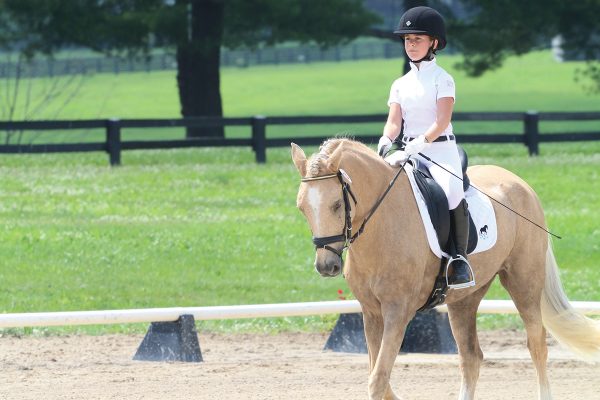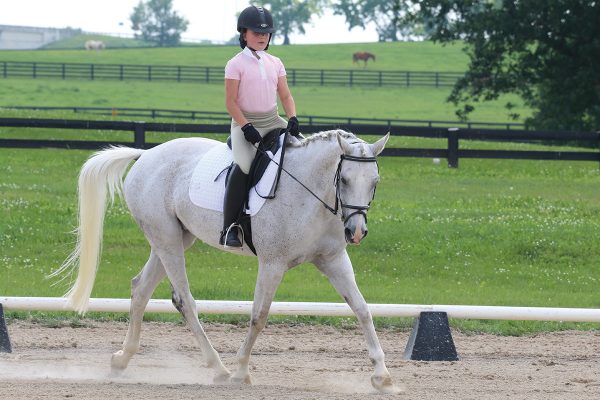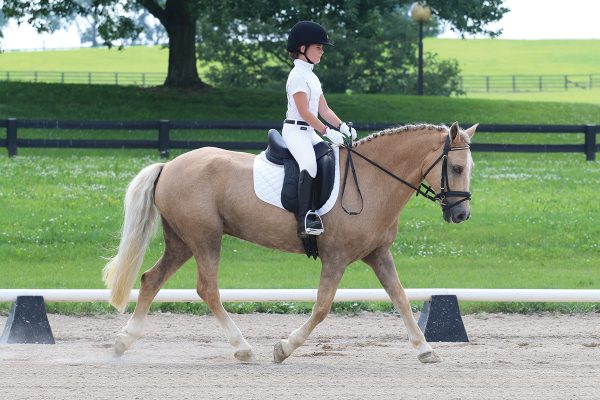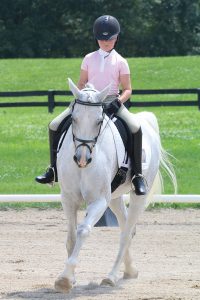No matter what kind of riding you do, dressage work can make it better! Correct dressage practice makes a horse stronger, more balanced, more supple, and more comfortable to ride. Two main dressage tips —keeping your horse straight and riding accurately — are two things any rider can practice in schooling sessions to make their horse more fun to sit on.

“Dressage work helps all horses,” says dressage trainer and judge Katy Barglow. As a national examiner for the United States Pony Clubs, Katy works with many youth riders who are earning their Pony Club certifications.
Improve Accuracy
Accuracy counts in dressage. When riding a dressage test, you are judged on how precisely you and your horse perform the pattern and movements, including making figures and transitions at the right place.
“Practicing accuracy helps improve your control and develops a more responsive horse,” says Katy.
Here are some of Katy’s favorite exercises to help her dressage students work on accuracy.
1. Exact Transitions
Try to do a transition exactly at a letter (or a tree, a post, a bush, et cetera). To transition exactly at that marker, notice when you have to start asking your horse to change his gait. Is it two strides out, or six strides out? Does he respond faster to upward or downward transitions? As you work on this exercise, most horses will become more responsive, says Katy.
2. A Perfect 10
From a walk, can you trot exactly 10 strides, then return to a walk? Or does it become 12 or 14 strides instead? How about trot to canter? Count your strides and learn what you need to do to prepare your horse to transition smoothly, without going over the number of strides.
3. Counting Strides
How many trot strides does your horse take on a 20-meter circle, or a diagonal? Or between two cones or poles? Is it the same every time, or different? If you ride a lengthening or shortening of stride (versus just speeding up or slowing down), does the number of strides go up or down?

You can also do this in between two ground poles. This exercise will help you focus on keeping a consistent pace, or rhythm and tempo. Counting the strides also lets you know if your figures (circles and diagonals) are consistent, or if they bow in or out or change in size.
Staying Straight
Straightness refers to the alignment of the horse’s body while moving. Correct alignment is important to have a horse that is equally flexible in both directions, balanced on both sides of his body, and able to take even contact.
When a horse’s body is straight, his hind legs follow exactly in the path of his front legs. This is true on straight lines, as well as circles and turns.
Your horse can only be straight if you are too! You must sit evenly and balanced in the saddle. Most horses—and their riders—have one side that is less flexible, which makes it challenging to stay straight.
Spot the Stiff Side
To start, Katy says you need to identify which side is your horse’s stiff side. To do this, ride a circle left and right and watch your horse’s ears—does he tip his head outside one way and inside going the other way?

Next, ride a straight line left and right, ideally toward a mirror or camera. Does your horse track straight, or do his haunches always swing right and his nose swings left? Katy says this is very common and leads to the horse being counter-bent when going right. You will probably find that your horse prefers not to bend in the direction of his stiff side and takes a stronger contact on the rein on this side.
“All horses and riders struggle with straightness, at all levels—it’s an ongoing battle and takes constant awareness,” says Katy.
Also look at your position as a rider: Do you sit in the middle, or do you tip or lean to one side, or collapse one hip so that one shoulder is lower than the other?
“Our feeling of how straight we are sitting versus how we are actually sitting is often very far off,” explains Katy. “A rider who sits to the left is convinced she is in the middle, and when you get her to sit in the middle, she is convinced she is a falling off to the right. Eyes on the ground or mirrors are essential to this work. Don’t trust your feel on this!”
Bending Aids Checklist

When we talk about bending aids, “inside” and “outside” refer to the direction of the bend.
◆ To bend your horse, sit up tall and look in the direction of the bend.
◆ Swivel your hips the same way, without leaning your upper body.
◆ With your inside leg at the girth, ask your horse to bend around your leg, moving his ribcage to the outside and elongating the outside of his body, while shortening the inside.
◆ Your outside leg should be positioned slightly behind the girth to keep your horse’s hind legs following in the path of his front legs and to prevent his haunches from swinging out.
◆ With your inside rein, ask your horse to flex his head and neck slightly to the inside, so you can just barely see his eyelashes. It can help to use an “opening rein” at the start, with your hand to the inside away from the neck, to help your horse understand what you want.
◆ Support with your outside rein to help your horse’s shoulders stay straight and keep his neck from overbending. This keeps his shoulders and haunches following his nose.
Bend to Go Straight
One of the main things Katy recommends to improve straightness is to practice bending.
“Using your bending aids works to make you and your horse straighter and able to bend more evenly to both sides, so that the horse turns with his nose, then his shoulder, then his haunches following the same line,” says Katy.
Practice the correct bend in your turns, on circles, and in corners. Remember to bend your horse’s entire body, not just his head and neck.
“You can also use leg-yields and turns on the forehand, under saddle or on the ground, to encourage the [horse’s] hind leg to cross under his body and his ribcage to bend and soften,” adds Katy. “And work on your own straightness! A crooked rider cannot make a straight horse.”
With good schooling, your horse can become more balanced and will be even more fun to ride
Meet the Trainer
Katy Barglow is a Grand Prix dressage rider and trainer in the San Francisco bay area of California, and a United States Pony Club graduate HA and National Examiner, as well as a USEF “R” dressage judge.
She is currently competing several horses of various breeds at the FEI (international) levels while also working in the biotech industry. Her son is a D1 level Pony Club member, and she loves to work with young riders!
This article about dressage tips appeared in the Winter 2022 issue of Young Rider magazine. Click here to subscribe!


